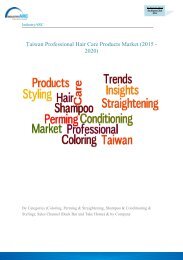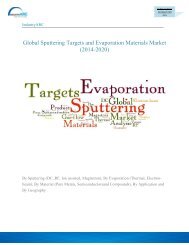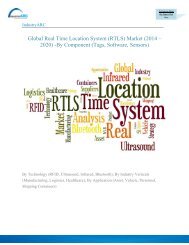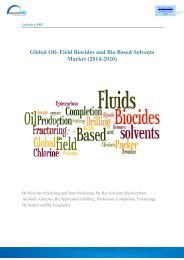Global Polyurethane Elastomers Market (2014 – 2020)
Polyurethane Elastomers are one of the most versatile polymers in today’s market whose performance and characteristics are designed in a way such that it can meet certain technical demands in the sector of elastomers. They have peculiar characteristics like excellent mechanical properties, good elastic and transparency characteristics, and resistance towards abrasion, light, ozone, to oxidation and atmospheric agents. Polyurethane elastomers are based on two classes – poly addition of diol-ester (AU) or diol-ethers (EU) with diisocyanate. The study includes the demand of this particular market on a global and regional scale for a six year period of 2014- 2020, both in terms of volume(kilo tons) and revenue($ million).
Polyurethane Elastomers are one of the most versatile polymers in today’s market whose performance and characteristics are designed in a way such that it can meet certain technical demands in the sector of elastomers. They have peculiar characteristics like excellent mechanical properties, good elastic and transparency characteristics, and resistance towards abrasion, light, ozone, to oxidation and atmospheric agents. Polyurethane elastomers are based on two classes – poly addition of diol-ester (AU) or diol-ethers (EU) with diisocyanate. The study includes the demand of this particular market on a global and regional scale for a six year period of 2014- 2020, both in terms of volume(kilo tons) and revenue($ million).
Create successful ePaper yourself
Turn your PDF publications into a flip-book with our unique Google optimized e-Paper software.
To Enquire About<br />
the Report Click<br />
Here<br />
IndustryARC<br />
<strong>Global</strong> <strong>Polyurethane</strong> <strong>Elastomers</strong> <strong>Market</strong> (<strong>2014</strong> <strong>–</strong> <strong>2020</strong>)<br />
By product Type (Thermoplastic elastomers, thermosetting elastomers); by<br />
Application Type (Automotive industry, electrical appliances, footwear, construction,<br />
others) and By Geography
To Enquire About<br />
the Report Click<br />
Here<br />
TABLE OF CONTENTS<br />
1. <strong>Global</strong> <strong>Polyurethane</strong> Elastomer <strong>–</strong> <strong>Market</strong> Overview<br />
2. Executive Summary<br />
3. <strong>Global</strong> <strong>Polyurethane</strong> Elastomer <strong>–</strong> <strong>Market</strong> Landscape<br />
3.1. <strong>Market</strong> Share Analysis<br />
3.2. Comparative Analysis<br />
3.2.1. Product Benchmarking<br />
3.2.2. End user profiling<br />
3.2.3. Top 5 Financials Analysis<br />
4. <strong>Global</strong> <strong>Polyurethane</strong> Elastomer <strong>–</strong> <strong>Market</strong> Forces<br />
4.1. <strong>Market</strong> Drivers<br />
4.2. <strong>Market</strong> Constraints<br />
4.3. <strong>Market</strong> Challenges<br />
4.4. Attractiveness of the <strong>Polyurethane</strong> Elastomer Industry<br />
4.4.1. Power of Suppliers<br />
4.4.2. Power of Customers<br />
4.4.3. Threat of New entrants<br />
4.4.4. Threat of Substitution<br />
4.4.5. Degree of Competition<br />
5. <strong>Global</strong> <strong>Polyurethane</strong> Elastomer <strong>Market</strong> <strong>–</strong> Strategic Analysis<br />
5.1. Value Chain Analysis<br />
5.2. Pricing Analysis<br />
5.3. Opportunities Analysis<br />
5.4. Product/<strong>Market</strong> Life Cycle Analysis<br />
5.5. Suppliers and Distributors
To Enquire About<br />
the Report Click<br />
Here<br />
6. <strong>Global</strong> <strong>Polyurethane</strong> Elastomer <strong>Market</strong> <strong>–</strong> By Product Type<br />
6.1. Thermoplastic <strong>Elastomers</strong><br />
6.1.1. Polyamide (Nylon)<br />
6.1.2. Polymethyl methacrylate<br />
6.1.3. Polypropylene<br />
6.1.4. Polystyrene<br />
6.1.5. Low density polythene<br />
6.1.6. High density polythene<br />
6.2. Thermosetting <strong>Elastomers</strong><br />
6.2.1. Latex<br />
6.2.2. Nitrile<br />
6.2.3. Milliable polyurethane<br />
6.2.4. Silicone<br />
6.2.5. Butyl<br />
6.2.6. Neoprene<br />
7. <strong>Global</strong> <strong>Polyurethane</strong> Elastomer <strong>Market</strong> <strong>–</strong> By Application<br />
7.1. Automotive Industry<br />
7.2. Construction<br />
7.3. Packaging<br />
7.4. Furniture and Interiors<br />
7.5. Footwear<br />
7.6. Electronics and Appliances<br />
7.7. Others (Textile, Medical, Mining )<br />
8. <strong>Global</strong> <strong>Polyurethane</strong> Elastomer <strong>Market</strong> -Geographic Analysis<br />
8.1. Introduction
To Enquire About<br />
the Report Click<br />
Here<br />
8.2. Americas<br />
8.2.1. North America<br />
8.2.2. Brazil<br />
8.2.3. Argentina<br />
8.2.4. Mexico<br />
8.2.5. Others<br />
8.3. Europe<br />
8.3.1. UK<br />
8.3.2. France<br />
8.3.3. Germany<br />
8.3.4. Italy<br />
8.3.5. Others<br />
8.4. APAC<br />
8.4.1. China<br />
8.4.2. India<br />
8.4.3. Japan<br />
8.4.4. Australia<br />
8.4.5. Others<br />
8.5. ROW<br />
9. <strong>Market</strong> Entropy<br />
9.1. New Product Launches<br />
9.2. M&As, Collaborations, JVs and Partnerships<br />
10. Investment Opportunities <strong>–</strong> Analysis by Target companies/customers, Capital Investments,<br />
ROI, Payback Period and Source of Funds.<br />
11. Company Profiles (Overview, Financials, SWOT Analysis, Developments, Product Portfolio)<br />
11.1. BASF SE
To Enquire About<br />
the Report Click<br />
Here<br />
11.2. Bayer Material Science AG<br />
11.3. Chemtura Corporation<br />
11.4. Chematur International AB<br />
11.5. COIM S.P.A<br />
11.6. DuPont DE Nemours and Company<br />
11.7. Fxi-Foamex Innovations<br />
11.8. Hebei Cangzhou Dahua Group co. Ltd<br />
11.9. Huntsman Corporation<br />
11.10. Mitsui Chemicals Inc.<br />
11.11. Fulflex, Inc.<br />
11.12. Fabreeka International, Inc<br />
11.13. Gardico, Inc.<br />
11.14. Dow Chemical Company<br />
11.15. Nippon <strong>Polyurethane</strong> Industry co. Ltd.<br />
11.16. Trelleborg AG<br />
11.17. Woodbridge Foam Corporation<br />
11.18. Yantai Wanhua <strong>Polyurethane</strong>s co. Ltd<br />
11.19. Recticel SA<br />
11.20. Northstar Polymers, LLC<br />
12. Appendix<br />
12.1. Abbreviations<br />
12.2. Sources<br />
12.3. Research Methodology<br />
12.4. Bibliography<br />
12.5. Compilation of Expert Insights
12.6. Disclaimer<br />
To Enquire About<br />
the Report Click<br />
Here
To Enquire About<br />
the Report Click<br />
Here<br />
LIST OF TABLES<br />
Table 1 <strong>Global</strong> <strong>Polyurethane</strong> Elastomer <strong>Market</strong> <strong>–</strong> Pricing Analysis ($)<br />
Table 2 <strong>Global</strong> <strong>Polyurethane</strong> Elastomer <strong>Market</strong> Revenue, By Type, <strong>2014</strong>-<strong>2020</strong> ($M)<br />
Table 3 <strong>Global</strong> <strong>Polyurethane</strong> Elastomer <strong>Market</strong> Volume, By Type, <strong>2014</strong>-<strong>2020</strong> (Kilo Tons)<br />
Table 4 <strong>Global</strong> <strong>Polyurethane</strong> Elastomer <strong>Market</strong> Revenue, By Application, <strong>2014</strong>-<strong>2020</strong> ($M)<br />
Table 5 <strong>Global</strong> <strong>Polyurethane</strong> Elastomer <strong>Market</strong> Volume, By Application, <strong>2014</strong>-<strong>2020</strong> (Kilo<br />
Tons)<br />
Table 6 <strong>Global</strong> <strong>Polyurethane</strong> Elastomer <strong>Market</strong> Revenue, By Geography, <strong>2014</strong>-<strong>2020</strong> ($M)<br />
Table 7 <strong>Global</strong> <strong>Polyurethane</strong> Elastomer <strong>Market</strong> Volume, By Geography, <strong>2014</strong>-<strong>2020</strong> (Kilo<br />
Tons)<br />
Table 8 <strong>Global</strong> Thermoplastic <strong>Elastomers</strong> <strong>Market</strong> Revenue, By Application, <strong>2014</strong>-<strong>2020</strong> ($M)<br />
Table 9 <strong>Global</strong> Thermoplastic <strong>Elastomers</strong> <strong>Market</strong> Volume, By Application, <strong>2014</strong>-<strong>2020</strong> (Kilo<br />
Tons)<br />
Table 10 <strong>Global</strong> Polyamide (Nylon) <strong>Market</strong> Revenue, By Application, <strong>2014</strong>-<strong>2020</strong> ($M)<br />
Table 11 <strong>Global</strong> Polyamide (Nylon) <strong>Market</strong> Volume, By Application, <strong>2014</strong>-<strong>2020</strong> (kilo tons)<br />
Table 12 <strong>Global</strong> Polymethyl methacrylate <strong>Market</strong> Revenue, By Application, <strong>2014</strong>-<strong>2020</strong> ($M)<br />
Table 13 <strong>Global</strong> Polymethyl methacrylate <strong>Market</strong> Volume, By Application, <strong>2014</strong>-<strong>2020</strong> (kilo<br />
tons)<br />
Table 14 <strong>Global</strong> Polypropylene <strong>Market</strong> Revenue, By Application, <strong>2014</strong>-<strong>2020</strong> ($M)<br />
Table 15 <strong>Global</strong> Polypropylene <strong>Market</strong> Volume, By Application, <strong>2014</strong>-<strong>2020</strong> (kilo tons)<br />
Table 16 <strong>Global</strong> Polystyrene <strong>Market</strong> Revenue, By Application, <strong>2014</strong>-<strong>2020</strong> ($M)<br />
Table 17 <strong>Global</strong> Polystyrene <strong>Market</strong> Volume, By Application, <strong>2014</strong>-<strong>2020</strong> (kilo tons)<br />
Table 18 <strong>Global</strong> Low density polythene <strong>Market</strong> Revenue, By Application, <strong>2014</strong>-<strong>2020</strong> ($M)<br />
Table 19 <strong>Global</strong> Low density polythene <strong>Market</strong> Volume, By Application, <strong>2014</strong>-<strong>2020</strong> (kilo tons)<br />
Table 20 <strong>Global</strong> High density polythene <strong>Market</strong> Revenue, By Application, <strong>2014</strong>-<strong>2020</strong> ($M)<br />
Table 21 <strong>Global</strong> High density polythene <strong>Market</strong> Volume, By Application, <strong>2014</strong>-<strong>2020</strong> (kilo tons)<br />
Table 22 <strong>Global</strong> Thermosetting <strong>Elastomers</strong> <strong>Market</strong> Revenue, By Application, <strong>2014</strong>-<strong>2020</strong> ($M)<br />
Table 23 <strong>Global</strong> Thermosetting <strong>Elastomers</strong> <strong>Market</strong> Volume, By Application, <strong>2014</strong>-<strong>2020</strong> (kilo<br />
tons)<br />
Table 24 <strong>Global</strong> Latex <strong>Market</strong> Revenue, By Application, <strong>2014</strong>-<strong>2020</strong> ($M)<br />
Table 25 <strong>Global</strong> Latex <strong>Market</strong> Volume, By Application, <strong>2014</strong>-<strong>2020</strong> (kilo tons)<br />
Table 26 <strong>Global</strong> Nitrile <strong>Market</strong> Revenue, By Application, <strong>2014</strong>-<strong>2020</strong> ($M)<br />
Table 27 <strong>Global</strong> Nitrile <strong>Market</strong> Volume, By Application, <strong>2014</strong>-<strong>2020</strong> (kilo tons)<br />
Table 28 <strong>Global</strong> Milliable polyurethane <strong>Market</strong> Revenue, <strong>2014</strong>-<strong>2020</strong> ($M)
To Enquire About<br />
the Report Click<br />
Here<br />
Table 29 <strong>Global</strong> Milliable polyurethane <strong>Market</strong> Volume, <strong>2014</strong>-<strong>2020</strong> (kilo tons)<br />
Table 30 <strong>Global</strong> Silicone <strong>Market</strong> Revenue, <strong>2014</strong>-<strong>2020</strong> ($M)<br />
Table 31 <strong>Global</strong> Silicone <strong>Market</strong> Volume, <strong>2014</strong>-<strong>2020</strong> (kilo tons)<br />
Table 32 <strong>Global</strong> Butyl <strong>Market</strong> Revenue, <strong>2014</strong>-<strong>2020</strong> ($M)<br />
Table 33 <strong>Global</strong> Butyl <strong>Market</strong> Volume, <strong>2014</strong>-<strong>2020</strong> (kilo tons)<br />
Table 34 <strong>Global</strong> Neoprene <strong>Market</strong> Revenue, <strong>2014</strong>-<strong>2020</strong> ($M)<br />
Table 35 <strong>Global</strong> Neoprene <strong>Market</strong> Volume, <strong>2014</strong>-<strong>2020</strong> (kilo tons)<br />
Table 36 Americas <strong>Polyurethane</strong> Elastomer <strong>Market</strong> Revenue, By Type, <strong>2014</strong>-<strong>2020</strong> ($M)<br />
Table 37 Americas <strong>Polyurethane</strong> Elastomer <strong>Market</strong> Volume, By Type, <strong>2014</strong>-<strong>2020</strong> (Kilo Tons)<br />
Table 38 Americas <strong>Polyurethane</strong> Elastomer <strong>Market</strong> Revenue, By Application, <strong>2014</strong>-<strong>2020</strong> ($M)<br />
Table 39 Americas <strong>Polyurethane</strong> Elastomer <strong>Market</strong> Volume, By Application, <strong>2014</strong>-<strong>2020</strong> (Kilo<br />
Tons)<br />
Table 40 Americas <strong>Polyurethane</strong> Elastomer <strong>Market</strong> Revenue, By Country, <strong>2014</strong>-<strong>2020</strong> ($M)<br />
Table 41 Americas <strong>Polyurethane</strong> Elastomer <strong>Market</strong> Volume, By Country, <strong>2014</strong>-<strong>2020</strong> (Kilo<br />
Tons)<br />
Table 42 APAC <strong>Polyurethane</strong> Elastomer <strong>Market</strong> Revenue, By Type, <strong>2014</strong>-<strong>2020</strong> ($M)<br />
Table 43 APAC <strong>Polyurethane</strong> Elastomer <strong>Market</strong> Volume, By Type, <strong>2014</strong>-<strong>2020</strong> (Kilo Tons)<br />
Table 44 APAC <strong>Polyurethane</strong> Elastomer <strong>Market</strong> Revenue, By Application, <strong>2014</strong>-<strong>2020</strong> ($M)<br />
Table 45 APAC <strong>Polyurethane</strong> Elastomer <strong>Market</strong> Volume, By Application, <strong>2014</strong>-<strong>2020</strong> (Kilo<br />
Tons)<br />
Table 46 APAC <strong>Polyurethane</strong> Elastomer <strong>Market</strong> Revenue, By Country, <strong>2014</strong>-<strong>2020</strong> ($M)<br />
Table 47 APAC <strong>Polyurethane</strong> Elastomer <strong>Market</strong> Volume, By Country, <strong>2014</strong>-<strong>2020</strong> (Kilo Tons)<br />
Table 48 Europe <strong>Polyurethane</strong> Elastomer <strong>Market</strong> Revenue, By Type, <strong>2014</strong>-<strong>2020</strong> ($M)<br />
Table 49 Europe <strong>Polyurethane</strong> Elastomer <strong>Market</strong> Volume, By Type, <strong>2014</strong>-<strong>2020</strong> (Kilo Tons)<br />
Table 50 Europe <strong>Polyurethane</strong> Elastomer <strong>Market</strong> Revenue, By Application, <strong>2014</strong>-<strong>2020</strong> ($M)<br />
Table 51 Europe <strong>Polyurethane</strong> Elastomer <strong>Market</strong> Volume, By Application, <strong>2014</strong>-<strong>2020</strong> (Kilo<br />
Tons)<br />
Table 52 Europe <strong>Polyurethane</strong> Elastomer <strong>Market</strong> Revenue, By Country, <strong>2014</strong>-<strong>2020</strong> ($M)<br />
Table 53 Europe <strong>Polyurethane</strong> Elastomer <strong>Market</strong> Volume, By Country, <strong>2014</strong>-<strong>2020</strong> (Kilo Tons)<br />
Table 54 RoW <strong>Polyurethane</strong> Elastomer <strong>Market</strong> Revenue, By Type, <strong>2014</strong>-<strong>2020</strong> ($M)<br />
Table 55 RoW <strong>Polyurethane</strong> Elastomer <strong>Market</strong> Volume, By Type, <strong>2014</strong>-<strong>2020</strong> (Kilo Tons)<br />
Table 56 RoW <strong>Polyurethane</strong> Elastomer <strong>Market</strong> Revenue, By Application, <strong>2014</strong>-<strong>2020</strong> ($M)<br />
Table 57 RoW <strong>Polyurethane</strong> Elastomer <strong>Market</strong> Volume, By Application, <strong>2014</strong>-<strong>2020</strong> (Kilo<br />
Tons)
To Enquire About<br />
the Report Click<br />
Here<br />
Table 58 RoW <strong>Polyurethane</strong> Elastomer <strong>Market</strong> Revenue, By Country, <strong>2014</strong>-<strong>2020</strong> ($M)<br />
Table 59 RoW <strong>Polyurethane</strong> Elastomer <strong>Market</strong> Volume, By Country, <strong>2014</strong>-<strong>2020</strong> (Kilo Tons)<br />
Table 60 <strong>Global</strong> Thermoplastic <strong>Elastomers</strong> <strong>Market</strong> Revenue, By Geography, <strong>2014</strong>-<strong>2020</strong> ($M)<br />
Table 61 <strong>Global</strong> Thermoplastic <strong>Elastomers</strong> <strong>Market</strong> Volume, By Geography, <strong>2014</strong>-<strong>2020</strong> (Kilo<br />
Tons)<br />
Table 62 <strong>Global</strong> Polyamide (Nylon) <strong>Market</strong> Revenue, By Geography, <strong>2014</strong>-<strong>2020</strong> ($M)<br />
Table 63 <strong>Global</strong> Polyamide (Nylon) <strong>Market</strong> Volume, By Geography, <strong>2014</strong>-<strong>2020</strong> (kilo tons)<br />
Table 64 <strong>Global</strong> Polymethyl methacrylate <strong>Market</strong> Revenue, By Geography, <strong>2014</strong>-<strong>2020</strong> ($M)<br />
Table 65 <strong>Global</strong> Polymethyl methacrylate <strong>Market</strong> Volume, By Geography, <strong>2014</strong>-<strong>2020</strong> (kilo<br />
tons)<br />
Table 66 <strong>Global</strong> Polypropylene <strong>Market</strong> Revenue, By Geography, <strong>2014</strong>-<strong>2020</strong> ($M)<br />
Table 67 <strong>Global</strong> Polypropylene <strong>Market</strong> Volume, By Geography, <strong>2014</strong>-<strong>2020</strong> (kilo tons)<br />
Table 68 <strong>Global</strong> Polystyrene <strong>Market</strong> Revenue, By Geography, <strong>2014</strong>-<strong>2020</strong> ($M)<br />
Table 69 <strong>Global</strong> Polystyrene <strong>Market</strong> Volume, By Geography, <strong>2014</strong>-<strong>2020</strong> (kilo tons)<br />
Table 70 <strong>Global</strong> Low density polythene <strong>Market</strong> Revenue, By Geography, <strong>2014</strong>-<strong>2020</strong> ($M)<br />
Table 71 <strong>Global</strong> Low density polythene <strong>Market</strong> Volume, By Geography, <strong>2014</strong>-<strong>2020</strong> (kilo tons)<br />
Table 72 <strong>Global</strong> High density polythene <strong>Market</strong> Revenue, By Geography, <strong>2014</strong>-<strong>2020</strong> ($M)<br />
Table 73 <strong>Global</strong> High density polythene <strong>Market</strong> Volume, By Geography, <strong>2014</strong>-<strong>2020</strong> (kilo tons)<br />
Table 74 <strong>Global</strong> Thermosetting <strong>Elastomers</strong> <strong>Market</strong> Revenue, By Geography, <strong>2014</strong>-<strong>2020</strong> ($M)<br />
Table 75 <strong>Global</strong> Thermosetting <strong>Elastomers</strong> <strong>Market</strong> Volume, By Geography, <strong>2014</strong>-<strong>2020</strong> (kilo<br />
tons)<br />
Table 76 <strong>Global</strong> Latex <strong>Market</strong> Revenue, By Geography, <strong>2014</strong>-<strong>2020</strong> ($M)<br />
Table 77 <strong>Global</strong> Latex <strong>Market</strong> Volume, By Geography, <strong>2014</strong>-<strong>2020</strong> (kilo tons)<br />
Table 78 <strong>Global</strong> Nitrile <strong>Market</strong> Revenue, By Geography, <strong>2014</strong>-<strong>2020</strong> ($M)<br />
Table 79 <strong>Global</strong> Nitrile <strong>Market</strong> Volume, By Geography, <strong>2014</strong>-<strong>2020</strong> (kilo tons)<br />
Table 80 <strong>Global</strong> Milliable polyurethane <strong>Market</strong> Revenue, By Geography,<strong>2014</strong>-<strong>2020</strong> ($M)<br />
Table 81 <strong>Global</strong> Milliable polyurethane <strong>Market</strong> Volume, By Geography, <strong>2014</strong>-<strong>2020</strong> (kilo tons)<br />
Table 82 <strong>Global</strong> Silicone <strong>Market</strong> Revenue, By Geography,<strong>2014</strong>-<strong>2020</strong> ($M)<br />
Table 83 <strong>Global</strong> Silicone <strong>Market</strong> Volume, By Geography, <strong>2014</strong>-<strong>2020</strong> (kilo tons)<br />
Table 84 <strong>Global</strong> Butyl <strong>Market</strong> Revenue, By Geography ,<strong>2014</strong>-<strong>2020</strong> ($M)<br />
Table 85 <strong>Global</strong> Butyl <strong>Market</strong> Volume, By Geography,<strong>2014</strong>-<strong>2020</strong> (kilo tons)<br />
Table 86 <strong>Global</strong> Neoprene <strong>Market</strong> Revenue, By Geography, <strong>2014</strong>-<strong>2020</strong> ($M)<br />
Table 87 <strong>Global</strong> Neoprene <strong>Market</strong> Volume, By Geography,<strong>2014</strong>-<strong>2020</strong> (kilo tons)<br />
Table 88 M&A, Product Launches, 2010-2015
To Enquire About<br />
the Report Click<br />
Here<br />
LIST OF FIGURES<br />
Figure1 <strong>Global</strong> <strong>Polyurethane</strong> Elastomer <strong>Market</strong>, By Geography, <strong>2014</strong> - <strong>2020</strong> ($M)<br />
Figure2 Segmentation of <strong>Global</strong> <strong>Polyurethane</strong> Elastomer <strong>Market</strong><br />
Figure3 <strong>Global</strong> <strong>Polyurethane</strong> Elastomer <strong>Market</strong> Competitive Share Analysis, <strong>2014</strong>(%)<br />
Figure4 <strong>Global</strong> <strong>Polyurethane</strong> Elastomer <strong>Market</strong> Share, By Type, <strong>2014</strong> (%)<br />
Figure5 <strong>Global</strong> <strong>Polyurethane</strong> Elastomer <strong>Market</strong> Share, By Application, <strong>2014</strong> (%)<br />
Figure6 <strong>Global</strong> <strong>Polyurethane</strong> Elastomer <strong>Market</strong> Share, By Geography, <strong>2014</strong> (%)<br />
Figure7 Americas <strong>Polyurethane</strong> Elastomer <strong>Market</strong> Share, By Country, <strong>2014</strong> (%)<br />
Figure8 Europe <strong>Polyurethane</strong> Elastomer <strong>Market</strong> Share, By Country, <strong>2014</strong> (%)<br />
Figure9 APAC <strong>Polyurethane</strong> Elastomer <strong>Market</strong> Share, By Country, <strong>2014</strong> (%)<br />
Figure10 RoW <strong>Polyurethane</strong> Elastomer <strong>Market</strong> Share, By Country, <strong>2014</strong> (%)<br />
Figure11 <strong>Global</strong> <strong>Polyurethane</strong> Elastomer <strong>Market</strong> Recent Developments, By Year, 2012-2015
To Enquire About<br />
the Report Click<br />
Here<br />
1. GLOBAL POLYURETHANE ELASTOMER <strong>–</strong> MARKET<br />
OVERVIEW<br />
1.1. SCOPE<br />
<strong>Polyurethane</strong> <strong>Elastomers</strong> are one of the most versatile polymers in today’s market whose<br />
performance and characteristics are designed in a way such that it can meet certain technical<br />
demands in the sector of elastomers. They have peculiar characteristics like excellent mechanical<br />
properties, good elastic and transparency characteristics, and resistance towards abrasion, light,<br />
ozone, to oxidation and atmospheric agents. <strong>Polyurethane</strong> elastomers are based on two classes <strong>–</strong><br />
poly addition of diol-ester (AU) or diol-ethers (EU) with diisocyanate. The study includes the<br />
demand of this particular market on a global and regional scale for a six year period of <strong>2014</strong>-<br />
<strong>2020</strong>, both in terms of volume(kilo tons) and revenue($ million).<br />
MDI (Methylene diphenyl diisocyanate) and TDI (Toulene diisocyanate) are used as primary raw<br />
materials for polyurethanes. This study gives detailed information about the product value chain<br />
right from the beginning which includes raw materials till end-use. The market is evaluated based<br />
on the key attributes such as the power in the hands of producers and consumers, analysis on the<br />
degree of competition, and threats from substitutes and new entrants.<br />
This report provides a detailed forecast over major geographic regions like North America,<br />
Europe, Asia- Pacific and rest of the world that include key growth in regions such as Brazil.<br />
Some of the leading market participants which dominate the polyurethane elastomers industry<br />
are Dow chemicals, BASF SE, Bayer Material Science AG, Huntsman Corp, Dow Chemicals<br />
Company, Mitsui Chemicals Inc. and others.<br />
1.2. STAKEHOLDERS<br />
The following are the key stakeholders in the <strong>Global</strong> <strong>Polyurethane</strong> <strong>Elastomers</strong> <strong>Market</strong>.<br />
• Manufacturers of textiles<br />
• Raw material suppliers<br />
• Importers and exporters of chemicals<br />
• Service providers<br />
• Distributors<br />
• Machinery and Instrument suppliers<br />
• Public and private testing laboratories<br />
• Mixers and Millers
To Enquire About<br />
the Report Click<br />
Here<br />
2. EXECUTIVE SUMMARY<br />
<strong>Polyurethane</strong> elastomers can be processed on extrusion as well as injection, blow and<br />
compression molding equipment’s. Europe, Asia Pacific and the United States dominate the<br />
polyurethane market contributing around 95% of the global market. China is the largest market<br />
in Asia Pacific and one of the leading countries in terms of production and consumption of<br />
polyurethane elastomers. It accounted for over 25% of the global market and over 50% of the<br />
Asia Pacific market in 2012 which makes Asia Pacific the leading and the fastest soaring market<br />
estimated to grow with a CAGR of 6% in the years <strong>2014</strong>-<strong>2020</strong>. As a whole, the polyurethane<br />
market is expected to cross $73 billion by <strong>2020</strong>.<br />
The global market is projected to reach 9.5 million tons by the year 2015 driven by active<br />
demand from construction, furniture and automotive markets.<br />
SAMPLE TABLE: GLOBAL POLYURETHANE ELASTOMER MARKET REVENUE,<br />
BY PRODUCT TYPE, <strong>2014</strong> <strong>–</strong> <strong>2020</strong> ($M)<br />
Product Type <strong>2014</strong> 2015 2016 2017 2018 2019 <strong>2020</strong> CAGR<br />
%<br />
(2015-<br />
<strong>2020</strong>)<br />
Thermosetting<br />
xx xx xx xx Xx xx xx Xx<br />
elastomer<br />
Thermoplastic elastomer xx xx xx xx Xx xx xx Xx<br />
Total xx xx xx xx Xx xx xx Xx<br />
Source: IndustryARC Analysis, Expert Interviews<br />
Thermosetting elastomers and thermoplastic elastomers are the two types of the PU elastomers<br />
of which thermosetting hold the largest market share of around 75%. Apart from its outstanding<br />
toughness, durability and processing ease PU elastomer is a versatile performer that bridges the<br />
gap between rubber and plastics.
To Enquire About<br />
the Report Click<br />
Here<br />
GLOBAL CONSUMPTION OF POLYURETHANE ELASTOMERS, BY COUNTRY IN<br />
<strong>2014</strong> (%)<br />
china<br />
europe<br />
united states<br />
middle east/africa<br />
other asia<br />
korea<br />
taiwan<br />
central/south america<br />
eastern europe<br />
mexico<br />
Source: IndustryARC Analysis<br />
The major producing and consuming regions in the polyurethane elastomers market are China,<br />
Europe and the United States. Also, it is assumed that Asia Pacific will continue to dominate the<br />
industry in the years <strong>2014</strong>-<strong>2020</strong>. Over one-third of the global application of PU elastomers is the<br />
production of footwear followed by the furniture and interiors and the automotive industry.
To Enquire About<br />
the Report Click<br />
Here<br />
KEY MARKET INSIGHTS<br />
• Asia Pacific is the largest producer as well as a consumer of the polyurethane market<br />
growing with a CAGR of 6% in the years <strong>2014</strong>-<strong>2020</strong><br />
• The global PU market demand is expected to reach 22,060 kilo tons by <strong>2020</strong> and with a<br />
growing CAGR of 5% from <strong>2014</strong>-<strong>2020</strong><br />
• China is a major regional global market producer and consumer accounting for over 25%<br />
of the total regional demand in the year 2013<br />
• US was the dominating region of PU elastomer in North America and accounted over<br />
80% of the global PU market in the year 2013<br />
• Automotive applications are expected to be the most demand causing segment of<br />
<strong>Polyurethane</strong> elastomers growing at a CAGR of 5.5% from <strong>2014</strong>-<strong>2020</strong><br />
• The demand for PU elastomers in electronic appliances is expected to grow at a CAGR<br />
of 8% till <strong>2020</strong>
To Enquire About<br />
the Report Click<br />
Here<br />
RESEARCH METHODOLOGY<br />
The quantitative and qualitative data collected for the global polyurethane elastomer market<br />
report is from a combination of secondary and primary sources. Research interviews were<br />
conducted with senior executives and/or managers of leading global polyurethane elastomer<br />
solution providers. These Key Opinion Leaders (KOLs) were then provided a questionnaire<br />
to gather quantitative and qualitative inputs on their operations, performance, strategies and<br />
views on the overall market, including key developments and technology trends. Data from<br />
interviews is consolidated, checked for consistency and accuracy, and the final market<br />
numbers are again validated by experts. The global market was split by products, services and<br />
geography based on different factors like primary and secondary sources, understanding of<br />
the number of companies operating in each segment and also KOL insights.<br />
We have used various secondary sources such as directories, articles, white papers,<br />
newsletters, annual reports and paid databases such as OneSource, Hoovers and Factiva to<br />
identify and collect information for extensive technical and commercial study of the global<br />
polyurethane elastomers market.<br />
The key players in the market and its value chain were identified through secondary research<br />
and their market opinions were also gathered in a similar way through telephonic interviews<br />
and questionnaires. We have also studied the annual reports of these top market players.<br />
Interviews with key opinion leaders such as directors, managers, and marketing personnel<br />
were used extensively in understanding the need and emergence of global polyurethane<br />
elastomer market.<br />
The following secondary sources were also used in the production of report and in<br />
triangulation of data points.
To Enquire About<br />
the Report Click<br />
Here<br />
THE ARC ADVANTAGE<br />
An analytical model lies at the core of our process, ensuring logical consistency<br />
throughout our research. We complement the model with secondary data and<br />
interviews with industry experts to reflect the latest trends. With our final expert<br />
validation, we provide you with only the most accurate and actionable intelligence.<br />
THE ARC PROCESS<br />
Analytical<br />
Method<br />
Base Method<br />
Consolidation<br />
Method<br />
Delphi<br />
Verification<br />
1. Granular<br />
breakdown of<br />
drivers into<br />
factors<br />
2. Validate all<br />
factors in terms<br />
of their present<br />
impact on the<br />
market<br />
3. Assign weights<br />
to these factors in<br />
terms of their<br />
relevance and<br />
impact on the<br />
market<br />
1. Get a topdown<br />
estimate of<br />
the market<br />
2. Follow it up<br />
with a bottom-up<br />
estimate of the<br />
market<br />
3. Check<br />
forconsistency<br />
and new growth<br />
factors that are<br />
relevant over the<br />
next 10 Years<br />
1. Granular<br />
breakdown of<br />
drivers into<br />
factors<br />
2. Validate all<br />
factors in terms<br />
of their present<br />
impact on the<br />
market.<br />
3. Assign weights<br />
to these factors in<br />
terms of their<br />
relevance and<br />
impact on the<br />
market.<br />
1. Verify the<br />
findings of the<br />
model with<br />
experts from<br />
across the value<br />
chain<br />
2. Verify the<br />
findings with<br />
players across<br />
small and large<br />
enterprises<br />
3. Tweak the<br />
model and add<br />
new factors<br />
4. Build the<br />
Analytical Model<br />
4. Build the Base<br />
model<br />
4. Build the<br />
Consolidated<br />
Model<br />
4. Finalize the<br />
ARC Model<br />
ANALYTICAL MODEL BASE MODEL CONSOLIDATED MODEL ARC MODEL
To Enquire About<br />
the Report Click<br />
Here<br />
ABOUT US<br />
IndustryARC was started by a group of young, passionate professionals along with<br />
extensively experienced industry veterans across various business segments. Our focus and<br />
expertise is mainly in the field of analytics, market research and consulting. Our singular<br />
goal is to provide accurate and affordable research to our clients.<br />
Our research team has expertise in diverse fields like Automotive, Chemicals, Consumer<br />
Product & Services, Electronics, Food & Beverages, Healthcare etc., However diverse the<br />
expertise maybe, everyone in our team shares one common trait - we love data and we love<br />
providing solutions to clients using that data even more! Seeing your business flourish<br />
based on our solutions and strategy is what we love the most!<br />
IndustryARC publishes more than 30 reports on an annual basis in the mentioned<br />
Industries. Our reports are in-depth and high quality reports that can help decision makers<br />
frame better strategies for their business requirements. These reports can be further<br />
customized as per your needs.<br />
Disclaimer:<br />
• The reports sold by IndustryARC are limited publications containing valuable<br />
market information provided to a select group of customers in response to orders.<br />
• Our customers acknowledge and agree that any report bought from IndustryARC is<br />
for their own internal use and not for general publication or disclosure to third<br />
parties.<br />
• Our reports or part of the reports, information contained in the report, cannot be<br />
shared or resold to any other third party.<br />
• Disclosure to third parties, usage of data in a public document, article or blog by the<br />
customer can be done with prior permission taken from IndustryARC.<br />
For information regarding permissions and sales, contact:<br />
sales@industryarc.com | sanjay.matthews@industryarc.com
To Enquire About<br />
the Report Click<br />
Here<br />
IndustryARC<br />
+1 614 - 588 - 8538<br />
sales@industryarc.com<br />
Copyright © 2015 IndustryARC<br />
All Rights Reserved. This document contains highly confidential information and is the sole<br />
property of IndustryARC. No part of it may be circulated, copied, quoted, or otherwise<br />
reproduced without the approval of IndustryARC.

















